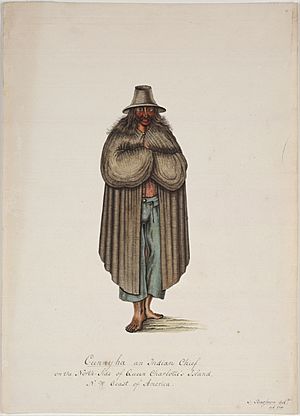Cuneah facts for kids
Cuneah (also spelled Gunia, Cunneah, and others) was an important leader of the Haida people. He was a chief of Kiusta, a village located on the northwestern tip of Graham Island. This island is part of Haida Gwaii, off the coast of British Columbia, Canada. Cuneah lived during a time when Europeans came to trade for valuable sea otter furs. Kiusta was a very important trading spot. Unlike some other Haida chiefs, Cuneah managed to avoid much of the conflict that happened during this trading period.
Meeting European Traders
In 1787, a British naval officer named George Dixon visited the area near Kiusta. He called the trading spot Cloak Bay. This was because he bought many beautiful sea otter cloaks from Cuneah's people there.
The first European to actually go ashore and meet Chief Cuneah was Captain William Douglas. This happened in June 1789. Cuneah and Douglas did something special: they exchanged names. This was a sign of friendship and respect among the Haida people. After this, trading ship logs often called the chief "Douglas Cuneah."
A Friendly Chief
Many American traders visited Cuneah's village. One of them described Cuneah as "humane" (kind) and "friendly." It is hard to find many details about Cuneah after Douglas's visit. This is because the old records are not complete.
Robert Haswell, who was on the ship Columbia Rediviva with Captain Robert Gray, wrote about events at Kiusta. Haswell said Cuneah was "a very good old fellow." He also noted that Cuneah's wife was on the ship and had "vast authority" over everyone nearby.
In 1793, an artist named Sigismund Bacstrom drew a picture of Cuneah's oldest daughter, Koota-Hilslinga.
Cuneah's Influence
Another description of Cuneah comes from Bishop's journal of the ship Ruby. In 1795, Bishop described Cuneah as the chief of the entire district. This likely meant the area around Kaigani Strait and much of the northern coast of Graham Island.
Cuneah had a major influence over the Haida people of Kiusta, Dadens, and Kaigani. Other important chiefs like Eldarge, Cowe, Skilkada, and Shakes were under Cuneah's leadership.
By 1811, Kiusta was no longer as important for the fur trade. Chief Cuneah was either very old or had passed away. His successor (the person who took his place) seemed to keep the name and title, but the village had lost its main importance.
See also


